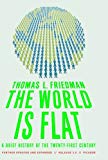
The World Is Flat is a book by Thomas Friedman discussing the trends of globalization in the 21st century. Friedman describes himself as a "free-trader," arguing in favor of the rapid shifts towards a more interconnected economic world after the fall of the USSR as a result of the Internet, computers, outsourcing and workflow software. Friedman also presents his controversial Dell Theory of Conflict Prevention: that corporations' increased dependency on foreign labor and resources will prevent armed conflict.
Does free trade still exist in a flat world? As he sets out to explore this dilemma, Friedman considers the banning of outsourcing, an action called for by many, to protect our country’s workers and the effect such an action would have on globalization. He concludes that erecting borders and walls would be detrimental to our goals and that Americans must instead be prepared to compete on a global playing field.
Friedman encourages better education and training, as Americans now compete not only with other Americans, but with the most brilliant minds around the globe for positions. We explore the“lump of labor” theory and new job creation in a global economy. He identifies the workers that will suffer most, should they be unable to keep ahead of the globalization trend, and offers large-scale suggestions to remedy this problem. Using the history of the American agricultural industry asan indicator of future trends in various industries today, he stresses the importance of an ability to adapt and specialize where there is a need. We learn that fear stimulates change and that this is a good thing.
Already have an account? Log In Now